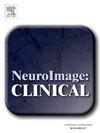Post-stroke changes in brain structure and function can both influence acute upper limb function and subsequent recovery
IF 3.6
2区 医学
Q2 NEUROIMAGING
引用次数: 0
Abstract
Improving outcomes after stroke depends on understanding both the causes of initial function/impairment and the mechanisms of recovery. Recovery in patients with initially low function/high impairment is variable, suggesting the factors relating to initial function/impairment are different to the factors important for subsequent recovery. Here we aimed to determine the contribution of altered brain structure and function to initial severity and subsequent recovery of the upper limb post-stroke.
The Nine-Hole Peg Test was recorded in week 1 and one-month post-stroke and used to divide 36 stroke patients (18 females, age: M = 66.56 years) into those with high/low initial function and high/low subsequent recovery. We determined differences in week 1 brain structure (Magnetic Resonance Imaging) and function (Magnetoencephalography, tactile stimulation) between high/low patients for both initial function and subsequent recovery. Lastly, we examined the relative contribution of changes in brain structure and function to recovery in patients with low levels of initial function.
Low initial function and low subsequent recovery are related to lower sensorimotor β power and greater lesion-induced disconnection of contralateral [ipsilesional] white-matter motor projection connections. Moreover, differences in intra-hemispheric connectivity (structural and functional) are unique to initial motor function, while differences in inter-hemispheric connectivity (structural and functional) are unique to subsequent motor recovery.
Function-related and recovery-related differences in brain function and structure after stroke are related, yet not identical. Separating out the factors that contribute to each process is key to identifying potential therapeutic targets for improving outcomes.
脑卒中后脑结构和功能的改变可影响急性上肢功能和随后的恢复
改善脑卒中后的预后取决于了解初始功能/损伤的原因和恢复机制。初始低功能/高功能损伤患者的恢复情况是可变的,这表明与初始功能/损伤相关的因素与对后续恢复重要的因素不同。在这里,我们的目的是确定脑结构和功能改变对中风后上肢初始严重程度和随后恢复的贡献。记录脑卒中后第1周和1个月的九孔栓试验,将36例脑卒中患者(女性18例,年龄M = 66.56岁)分为初始功能高/低、后续恢复高/低两组。我们确定了高/低患者在第1周的大脑结构(磁共振成像)和功能(脑磁图,触觉刺激)的差异,包括初始功能和随后的恢复。最后,我们研究了大脑结构和功能变化对低水平初始功能患者恢复的相对贡献。较低的初始功能和较低的随后恢复与较低的感觉运动β功率和更大的损伤引起的对侧白质运动投射连接断开有关。此外,半球内连通性(结构和功能)的差异是初始运动功能所特有的,而半球间连通性(结构和功能)的差异是随后运动恢复所特有的。脑卒中后脑功能和结构的功能相关和恢复相关差异是相关的,但不完全相同。分离出影响每个过程的因素是确定改善结果的潜在治疗靶点的关键。
本文章由计算机程序翻译,如有差异,请以英文原文为准。
求助全文
约1分钟内获得全文
求助全文
来源期刊

Neuroimage-Clinical
NEUROIMAGING-
CiteScore
7.50
自引率
4.80%
发文量
368
审稿时长
52 days
期刊介绍:
NeuroImage: Clinical, a journal of diseases, disorders and syndromes involving the Nervous System, provides a vehicle for communicating important advances in the study of abnormal structure-function relationships of the human nervous system based on imaging.
The focus of NeuroImage: Clinical is on defining changes to the brain associated with primary neurologic and psychiatric diseases and disorders of the nervous system as well as behavioral syndromes and developmental conditions. The main criterion for judging papers is the extent of scientific advancement in the understanding of the pathophysiologic mechanisms of diseases and disorders, in identification of functional models that link clinical signs and symptoms with brain function and in the creation of image based tools applicable to a broad range of clinical needs including diagnosis, monitoring and tracking of illness, predicting therapeutic response and development of new treatments. Papers dealing with structure and function in animal models will also be considered if they reveal mechanisms that can be readily translated to human conditions.
 求助内容:
求助内容: 应助结果提醒方式:
应助结果提醒方式:


